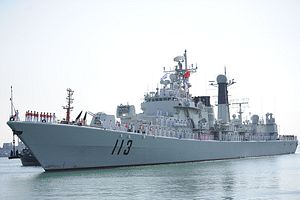This week, the Pentagon’s Office of Naval Intelligence (ONI) released an unclassified assessment of the Chinese navy’s new capabilities and missions in the years ahead.
Compared to ONI’s last unclassified analysis on the PLAN six years ago, the more than 300-ship strong Chinese People’s Liberation Army Navy (PLAN) has “made significant strides in operationalizing as well as modernizing its force,” notes the new 2015 report. Notably different from 2009 is Beijing’s current shipbuilding program, which is now focusing more on the construction of multi-mission vessels rather than anti-surface warfare combatants.
The most striking revelation of the 2015 ONI report is that the PLAN has apparently already equipped a class of guided missile destroyers with China’s most advanced supersonic anti-ship missile. “[T]he newest class, the LUYANG III destroyer is fitted with the new vertically-launched YJ-18 ASCM,” the report says.
Writing last week (see: “China’s ‘New’ Carrier Killer Subs”), I highlighted that this new weapon constitutes a major threat to U.S. and allied surface vessels deployed in Asian waters. As of now, only one Type 052D Luyang III-class destroyer is currently in service with the vertically launched YJ-18. However, the PLAN plans to commission ten more such vessels by 2017 and also plans to deploy the missile on Type-093G and Type-095 submarines.
“In 2013 and 2014, China launched more naval ships than any other country and is expected to continue this trend through 2015-16,” according to the study. In 2013, the PLAN either laid down, launched, or commissioned more than 60 ships, although the emphasis overall is on quality rather than size. Looking at just numbers, Beijing already fields a formidable naval force today:
As of this publishing, the PLA(N) consists of approximately 26 destroyers (21 of which are considered modern), 52 frigates (35 modern), 20 new corvettes, 85 modern missile armed patrol craft, 56 amphibious ships, 42 mine warfare ships (30 modern), more than 50 major auxiliary ships, and more than 400 minor auxiliary ships and service/support craft.
The PLAN’s submarine fleet currently deploys 66 boats — five nuclear-attack submarines, four nuclear ballistic-missile submarines, and 57 diesel attack submarines, although the report does not indicate how many of the vessels are, in fact, operational. Additionally, “by 2020 the submarine force will likely grow to more than 70 submarines,” ONI assesses.
Furthermore the paper notes that “[m]ajor qualitative improvements are occurring within naval aviation and the submarine force, which are increasingly capable of striking targets hundreds of miles from the Chinese mainland.”
The report also points out that China’s Coast Guard — its maritime law enforcement force — has undergone major modernization and is also increasing in size. Civilian maritime forces have “added approximately 100 new large patrol ships (WPS), patrol combatants/craft (WPG/WPC), and auxiliary/support ships, not including small harbor and riverine patrol boats. The current phase of the construction program, which began in 2012, will add over 30 large patrol ships and over 20 patrol combatants to the force by 2015.”
Other highlights of the report include the mentioning of hitherto little known Wonang-class inshore minesweepers and the confirmation that three Dalao-class submarine rescue ships are in service, as well as four Dongdiao-class intelligence collection ships.
Moreover, the Chinese Navy is rapidly developing ship-based drones. “The PLA(N) will probably emerge as one of China’s most prolific UAV users, employing UAVs to supplement manned ISR aircraft as well as to aid targeting for land-, ship-, and other air-launched weapons systems,” the report says. “UAVs will probably become one of the PLA(N)’s most valuable ISR assets.”
As expected, the ONI report points out that the PLAN is still suffering from lack of interoperability, making integrated jointed operations still a difficult proposition for the force:
Despite its considerable rhetorical emphasis on achieving this goal, the PLA’s record of achievement appears mixed during the past decade (…) PLA leaders and planners are committed to developing systems for conduct of joint operations, but they recognize the complexity of that task and are conscious of the fact that the PLA lacks real world experience.
Last, ONI believes that the commissioning of the Kuznetsov-class Liaoning aircraft carrier — despite “limited combat capability” — is a “milestone” signaling that the Chinese leadership has embraced the idea that fielding a large fleet is essential to achieving great power status.
































